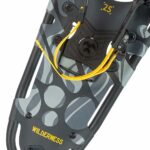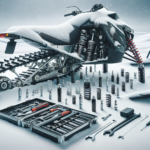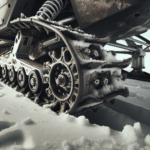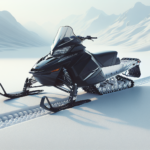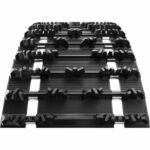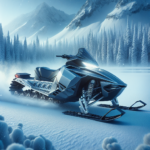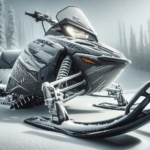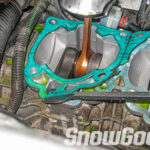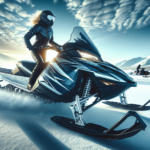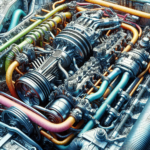Whether you’re a seasoned snowmobile vet or a dewy-eyed newbie bracing for your first thrilling ride through the snow-covered wilderness, it helps to master the basics of this awe-inspiring winter vehicle. Entitled “What Are The Parts Of A Snowmobile?”, this article breaks down everything you need to know about the essential components of a snowmobile that enable it to glide smoothly across icy terrains. From the engine to the track, and the skis to the suspension, get ready to boost your snowmobile knowledge and have a safer, more exciting ride.
Engine of a Snowmobile
The engine of a snowmobile is like the beating heart that propels it forward through the snow. It’s a precision-engineered piece of machinery that has many components working together in perfect harmony.
Combustion Chamber
In the guts of the engine is the combustion chamber. This is where the magic really happens. Fuel and air combine and ignite to provide the explosive power that drives your snowmobile. It’s a rough-and-tumble place, but with proper maintenance, the combustion chamber will keep delivering the power you need.
Camshaft
The camshaft plays a critical role in managing the input and output of gases in your engine. As it rotates, it opens and closes the engine’s valves at just the right moments. This precise timing allows your snowmobile to keep firing on all cylinders.
Cylinders
Speaking of cylinders, these are the places where the combustion occurs. The cylinders house the pistons and provide a space where fuel and air mix together. When the spark plug ignites this mixture, the resulting explosion pushes the piston, which generates the power that drives your snowmobile forward.
Pistons
Those pistions, serving as the heroes of the engine, endure tremendous pressure and heat every time you rev the engine. Their job is to convert the explosive force from the combustion chamber into mechanical energy. Their up-and-down motion drives the crankshaft, which, in turn, drives the track of your snowmobile.
Spark Plugs
The spark that ignites the fuel and air mixture comes from the engine’s spark plugs. These are critical for maintaining good engine performance and fuel economy. So, replacing your spark plugs regularly is a smart way to keep your snowmobile running smoothly.
Exhaust System
The exhaust system on your snowmobile carries away the waste gases produced by the combustion process. This keeps the engine clean and running efficiently, and it also reduces noise and pollution.
Snowmobile Track and Suspension
The track and suspension are the foundation of your snowmobile’s mobility on snowy terrain.
Track
The track of your snowmobile is the large, belt-like component that spins around and propels the vehicle forward. It’s made from durable rubber compound and it often has small metal studs embedded in it to provide better traction on ice and compacted snow.
Drive Lug
Attached to the inside of the track are hundreds of small protrusions known as drive lugs. These fit into the track-drive assembly and allow the track to rotate when the engine is engaged.
Sliders or Hyfax
The sliders, also known as hyfax, are plastic strips that protect the bottom of the skid frame from wear and damage. These strips are essential for prolonging the life of your snowmobile suspension system.
Idler Wheels
The idler wheels assist the track in its rotation, reducing friction and keeping the track properly tensioned. These wheels absorb some of the shocks and bumps on the trail, providing for a smoother ride.
Skid Frame
The skid frame provides support for the track and its various components. It’s the backbone of the whole track and suspension assembly.
Springs and Shocks
These components absorb most of the jarring shocks and vibrations that come from riding over rough terrain. They make your rides smoother and more comfortable, and they improve the snowmobile’s handling.
Snowmobile Body and Frame
The body of your snowmobile, a work of design and engineering, protects the internal components and contributes significantly to the overall performance of the machine.
Chassis
The chassis is essentially the skeleton of your snowmobile. It’s designed to be both light and strong, supporting the engine and other components while providing a platform for the body panels and seat.
Hood and Windshield
The hood and windshield help cut through the wind and shield you from snow and ice. They also add to the aerodynamic efficiency of the snowmobile.
Seat and Storage
Behind the handlebars is the seat, where you’ll be spending a lot of time. Next to the seat is the storage compartment that lets you bring along essential supplies and equipment for your snowmobile adventure.
Headlights and Taillights
These are critical for your safety when riding at night or in low-light conditions. They also ensure others on the trail can see you coming or going.
Handlebars
For controlling the direction and assisting in managing the snowmobile’s acceleration and braking, the handlebars are perhaps the most interacted-with component.
Braking System
The braking system is an essential safety feature of your snowmobile, allowing you to control your speed and stop when necessary.
Brake Disc
The brake disc, or rotor, is connected to the snowmobile’s track drive. When you engage the brakes, the brake calipers close around the disc, slowing its rotation and ultimately stopping the snowmobile.
Brake Pads
Brake pads reinforce the brake calipers, providing enough friction to slow down the rotation of the brake disc.
Brake Calipers
The brake calipers apply pressure to the brake pads, which in turn press against the brake disc, causing the snowmobile to slow down or stop.
Brake Fluid Reservoir
This component holds the brake fluid, which is essential for the operation of the braking system. As you apply brake pressure, the fluid moves in the system and causes the brake calipers to contract.
Brake Handle
The brake handle is what you squeeze to engage the brake system. It’s typically located on the left side of the handlebars for easy access.
Cooling System
Snowmobile engines can generate a great deal of heat, so the cooling system is vital for keeping temperatures under control.
Radiator
The radiator dissipates the heat generated by the engine. Hot coolant from the engine is pumped through the radiator tubes, where the heat is carried away by the colder ambient air.
Heat Exchanger
In many snowmobiles, the heat exchanger is part of the skid frame. It uses the snow that the sled is riding over to cool down the hot coolant that the engine has heated up.
Coolant
The coolant absorbs the heat from the engine and carries it away, passing through the heat exchanger or radiator before it cycles back to the engine.
Hoses
The hoses are pathways for the coolant. They’re flexible and durable, capable of withstanding the pressure and temperature of the engine’s coolant.
Fuel System
The fuel system ensures your engine gets the gas it needs to run cleanly and efficiently.
Fuel Tank
This is where the fuel for your snowmobile is stored. It usually has a cap to keep dirt and moisture out and a gauge to show you how much gas you have left.
Fuel Pump
The fuel pump sends fuel from the tank to the engine. It’s powered by your snowmobile’s electrical system and regulated by a pressure regulator.
Fuel Lines
Fuel lines are the vessels that transport fuel from the tank to the engine. They’re designed to resist heat, corrosion, and pressure, ensuring that the fuel reaches the engine safely.
Air Filter
The air filter cleans the air that’s entering the engine from dust and other particles. It’s essential for maintaining maximum engine performance and long engine life.
Electrical System
The electrical system manages all the electricity in your snowmobile, from providing power to start your engine to running your headlights.
Battery
The battery stores the electrical power your snowmobile needs to function. It supplies the electrical demands of your snowmobile when the engine isn’t running or when the alternator can’t keep up.
Ignition Switch
Your ignition switch starts the engine when you turn your key. It’s responsible for energizing the starter motor and igniting the engine.
Starter
The starter motor uses electricity from the battery to turn the crankshaft and start the engine.
Alternator
Once the engine is running, the alternator provides electrical power to the system and charges the battery.
Spark Plug Wires
The wires carry the electric current from the ignition system to the spark plugs, igniting the fuel-air mixture in the engine cylinders.
Headlights
Headlights illuminate the path ahead of you while riding. They’re a critical safety feature, especially when riding at night.
Transmission System
The transmission system delivers engine power to the snowmobile’s track, allowing it to move.
Drive Belt
The drive belt transfers the power from your snowmobile’s engine to its track.
Clutches
Your snowmobile has two clutches: a drive clutch attached to the engine and a driven clutch attached to the track-drive. As the engine accelerates, the drive clutch’s cones squeeze the belt, transferring power to the driven clutch, which spins the track.
Drive Shaft
The drive shaft is a rotating mechanical component that transfers power from the engine to the rest of the vehicle.
Chain case
The chain case houses the gears and chain that transmit power from the engine to the track. It is filled with oil to ensure smooth and efficient operation.
Snowmobile Skis
The skis provide control and steering as you glide over the snow.
Ski Materials
Snowmobile skis can be made from steel, aluminum, or plastic, with each material offering different advantages in terms of weight, durability, and performance.
Ski Runners
The runners are the bottom parts of the skis that come in contact with the snow. They have a specific design to improve steering and control in different snow conditions.
Ski Stance Width
The width between your skis, known as the ski stance, affects the handling and stability of your snowmobile. Generally, a wider stance provides more stability, while a narrower one improves maneuverability.
Ski Mounting Brackets
The mounting brackets connect the skis to the suspension system. They allow the skis to pivot as you steer.
Exhaust System
The exhaust system helps to remove waste gases from the engine, improving performance and making your snowmobile run quieter.
Exhaust Manifold
The exhaust manifold collects the exhaust gases from multiple cylinders into one pipe. It’s designed to quickly carry these gases away to minimize back pressure on the engine.
Muffler
Installed in the exhaust system, the muffler reduces the noise produced by the exhaust gases.
Pipe
The exhaust pipe carries the waste gases from the muffler and directs them out of the snowmobile.
Turbos and Silencers
Turbos and silencers are performance-enhancing and noise-reducing modifications for your exhaust system. A turbo increases power by forcing more air into the cylinders, while a silencer reduces noise.
After knowing the basic components of your snowmobile, you’re ready to hit the trails! Remember, a well-maintained snowmobile will not only improve your performance on the trails but also extend the longevity of your sled.
- What Snowboard Bindings Should I Get? - January 23, 2024
- What Size Screws For Snowboard Bindings? - January 23, 2024
- How To Snowmobile On Water? - January 23, 2024

